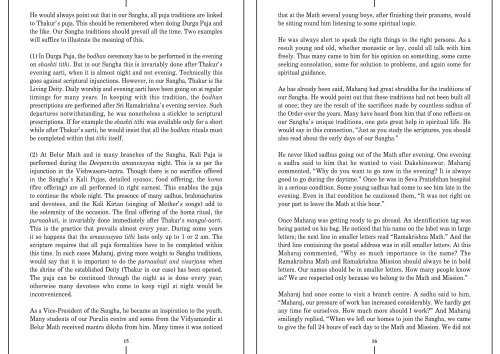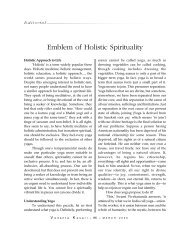Swami Prameyananda - Belur Math
Swami Prameyananda - Belur Math
Swami Prameyananda - Belur Math
Create successful ePaper yourself
Turn your PDF publications into a flip-book with our unique Google optimized e-Paper software.
He would always point out that in our Sangha, all puja traditions are linked<br />
to Thakur’s puja. This should be remembered when doing Durga Puja and<br />
the like. Our Sangha traditions should prevail all the time. Two examples<br />
will suffice to illustrate the meaning of this.<br />
(1) In Durga Puja, the bodhan ceremony has to be performed in the evening<br />
on shashti tithi. But in our Sangha this is invariably done after Thakur’s<br />
evening aarti, when it is almost night and not evening. Technically this<br />
goes against scriptural injunctions. However, in our Sangha, Thakur is the<br />
Living Deity. Daily worship and evening aarti have been going on at regular<br />
timings for many years. In keeping with this tradition, the bodhan<br />
prescriptions are performed after Sri Ramakrishna’s evening service. Such<br />
departures notwithstanding, he was nonetheless a stickler to scriptural<br />
prescriptions. If for example the shashti tithi was available only for a short<br />
while after Thakur’s aarti, he would insist that all the bodhan rituals must<br />
be completed within that tithi itself.<br />
(2) At <strong>Belur</strong> <strong>Math</strong> and in many branches of the Sangha, Kali Puja is<br />
performed during the Deepanvita amaavasyaa night. This is as per the<br />
injunction in the Vishwasara-tantra. Though there is no sacrifice offered<br />
in the Sangha’s Kali Pujas, detailed nyasas, food offering, the homa<br />
(fire offering) are all performed in right earnest. This enables the puja<br />
to continue the whole night. The presence of many sadhus, brahmacharins<br />
and devotees, and the Kali Kirtan (singing of Mother’s songs) add to<br />
the solemnity of the occasion. The final offering of the homa ritual, the<br />
purnaahuti, is invariably done immediately after Thakur’s mangal-aarti.<br />
This is the practice that prevails almost every year. During some years<br />
it so happens that the amaavasyaa tithi lasts only up to 1 or 2 am. The<br />
scripture requires that all puja formalities have to be completed within<br />
this time. In such cases Maharaj, giving more weight to Sangha traditions,<br />
would say that it is important to do the purnaahuti and visarjana when<br />
the shrine of the established Deity (Thakur in our case) has been opened.<br />
The puja can be continued through the night as is done every year;<br />
otherwise many devotees who come to keep vigil at night would be<br />
inconvenienced.<br />
As a Vice-President of the Sangha, he became an inspiration to the youth.<br />
Many students of our Purulia centre and some from the Vidyamandir at<br />
<strong>Belur</strong> <strong>Math</strong> received mantra diksha from him. Many times it was noticed<br />
15<br />
that at the <strong>Math</strong> several young boys, after finishing their pranams, would<br />
be sitting round him listening to some spiritual topic.<br />
He was always alert to speak the right things to the right persons. As a<br />
result young and old, whether monastic or lay, could all talk with him<br />
freely. Thus many came to him for his opinion on something, some came<br />
seeking consolation, some for solution to problems, and again some for<br />
spiritual guidance.<br />
As has already been said, Maharaj had great shraddha for the traditions of<br />
our Sangha. He would point out that these traditions had not been built all<br />
at once; they are the result of the sacrifices made by countless sadhus of<br />
the Order over the years. Many have heard from him that if one reflects on<br />
our Sangha’s unique traditions, one gets great help in spiritual life. He<br />
would say in this connection, “Just as you study the scriptures, you should<br />
also read about the early days of our Sangha.”<br />
He never liked sadhus going out of the <strong>Math</strong> after evening. One evening<br />
a sadhu said to him that he wanted to visit Dakshineswar. Maharaj<br />
commented, “Why do you want to go now in the evening? It is always<br />
good to go during the daytime.” Once he was in Seva Pratishthan hospital<br />
in a serious condition. Some young sadhus had come to see him late in the<br />
evening. Even in that condition he cautioned them, “It was not right on<br />
your part to leave the <strong>Math</strong> at this hour.”<br />
Once Maharaj was getting ready to go abroad. An identification tag was<br />
being pasted on his bag. He noticed that his name on the label was in large<br />
letters; the next line in smaller letters read “Ramakrishna <strong>Math</strong>.” And the<br />
third line containing the postal address was in still smaller letters. At this<br />
Maharaj commented, “Why so much importance to the name? The<br />
Ramakrishna <strong>Math</strong> and Ramakrishna Mission should always be in bold<br />
letters. Our names should be in smaller letters. How many people know<br />
us? We are respected only because we belong to the <strong>Math</strong> and Mission.”<br />
Maharaj had once come to visit a branch centre. A sadhu said to him,<br />
“Maharaj, our pressure of work has increased considerably. We hardly get<br />
any time for ourselves. How much more should I work?” And Maharaj<br />
smilingly replied, “When we left our homes to join the Sangha, we came<br />
to give the full 24 hours of each day to the <strong>Math</strong> and Mission. We did not<br />
16



